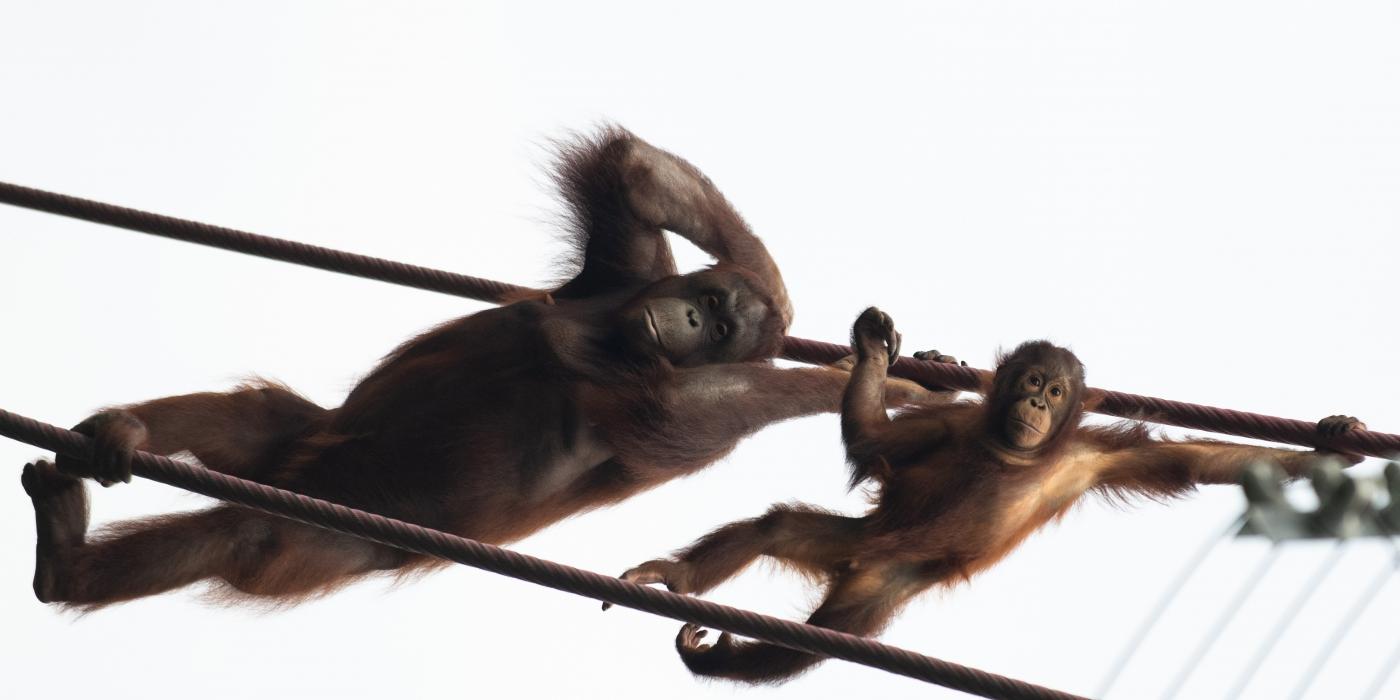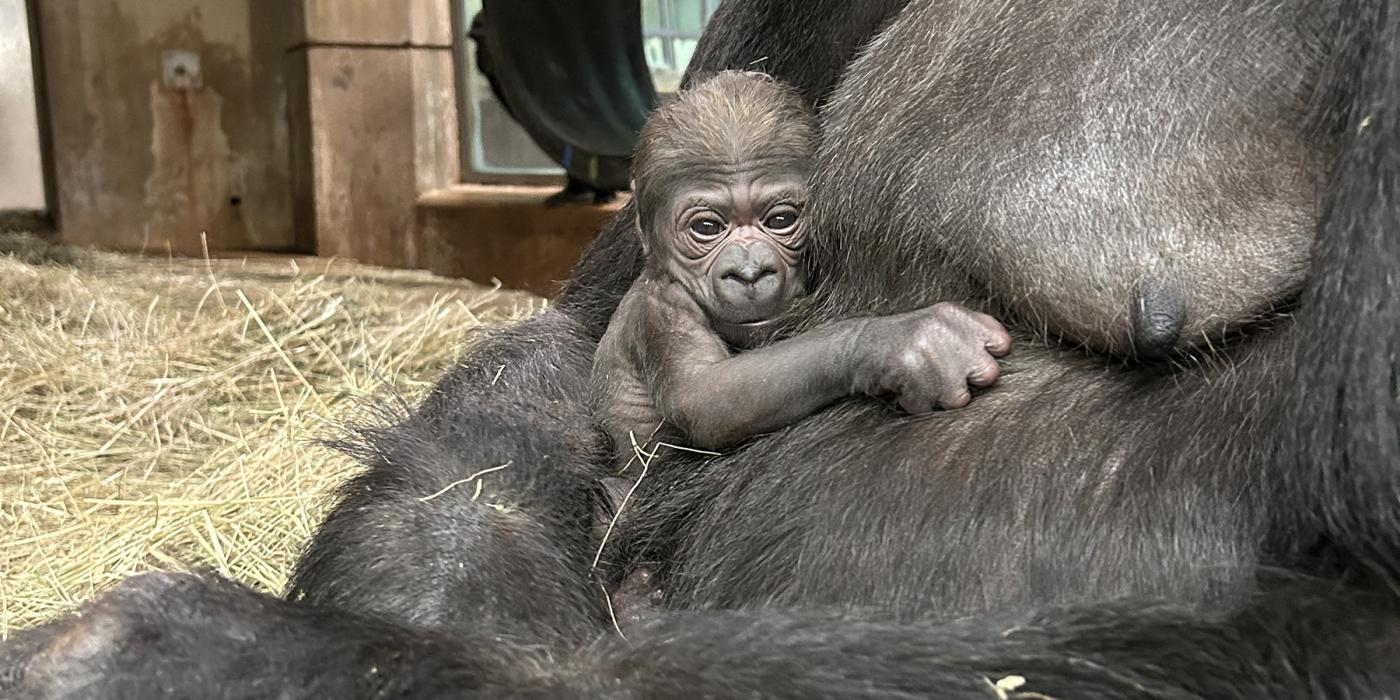#OrangutanStory: Happy 4th Birthday, Redd! (Part II)
Where has the time gone? It’s hard to believe that we are already celebrating our youngest Bornean orangutan’s fourth birthday!
Redd has grown so much over the past year. Now, he looks more like a juvenile—he is all arms and legs, gangly and strong. He currently weighs more than 30 pounds. Contrast Redd’s weight with that of our 2.5-year-old western lowland gorilla, Moke, who tips the scales at almost 50 pounds.
Though gorillas can climb trees, they are more suited to moving through their habitat on the ground. Their body structure is heavier and sturdier by design. Just look at Moke—he’s built like a little tank! Orangutans, on the other hand, are lanky and nimble, enabling them to move freely through the trees.
Much like our adult orangutans, Redd is very expressive. His mood seems to change constantly. In one moment, he is playful and wrestling with his aunties. In the next, he is sweetly cuddling with his mother, Batang. Redd has been known to throw temper tantrums, too, and will whine when he doesn’t get what he wants. This usually occurs when Batang has decided not to share her enrichment treats with him. He will make a high-pitched vocalization, throw himself on the ground and make his frustration known!
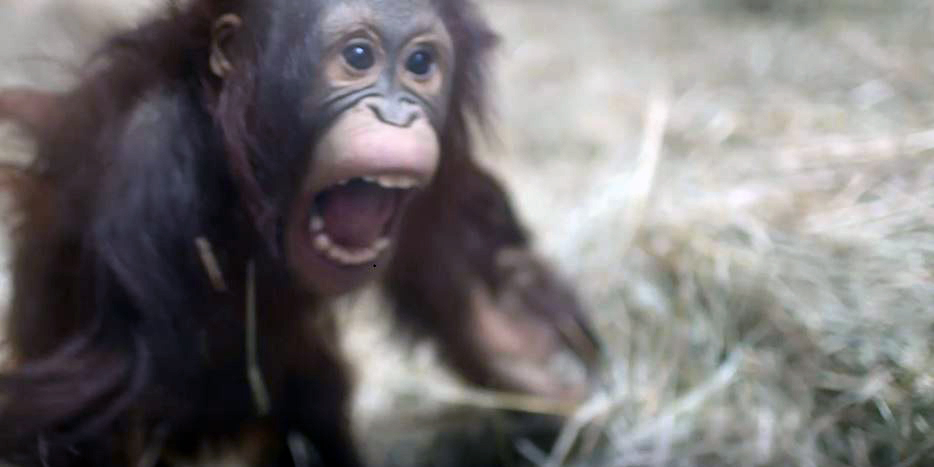
Redd has always been full of personality, and lately he’s been expressing how “tough” he is. One orangutan vocalization called a “kiss-squeak” usually signifies that they are upset at something or someone. Redd will kiss-squeak, though, when he is trying to show off his display skills. Along with vocalizing, he will toss toys and hay around the enclosure.
I’m sure his goal is to look intimidating and impressive—which is why adult males display and vocalize—but with his small stature, it is more comical. He gets an “A” for effort from me. As he gets older, these displays will become more significant as he navigates his role in our orangutan social network as a maturing male.
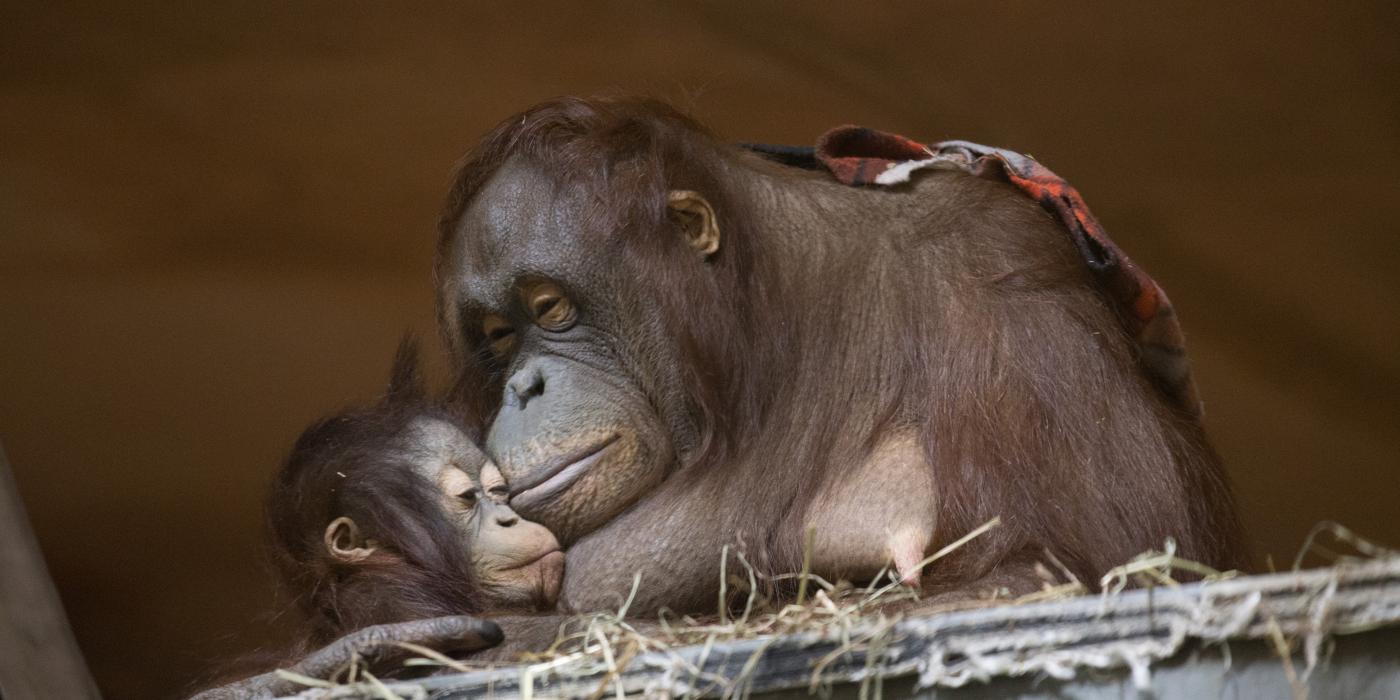
As often as Redd acts big and tough, he is still a juvenile and is closely bonded with Batang. During one of his recent impressive displays, he was swinging on the firehose in Think Tank and unexpectedly smacked into one of the suspended enrichment toys. Startled, he ran right over to Batang for comfort and started nursing. He was not physically injured in any way. He just needed some reassurance from his mother.
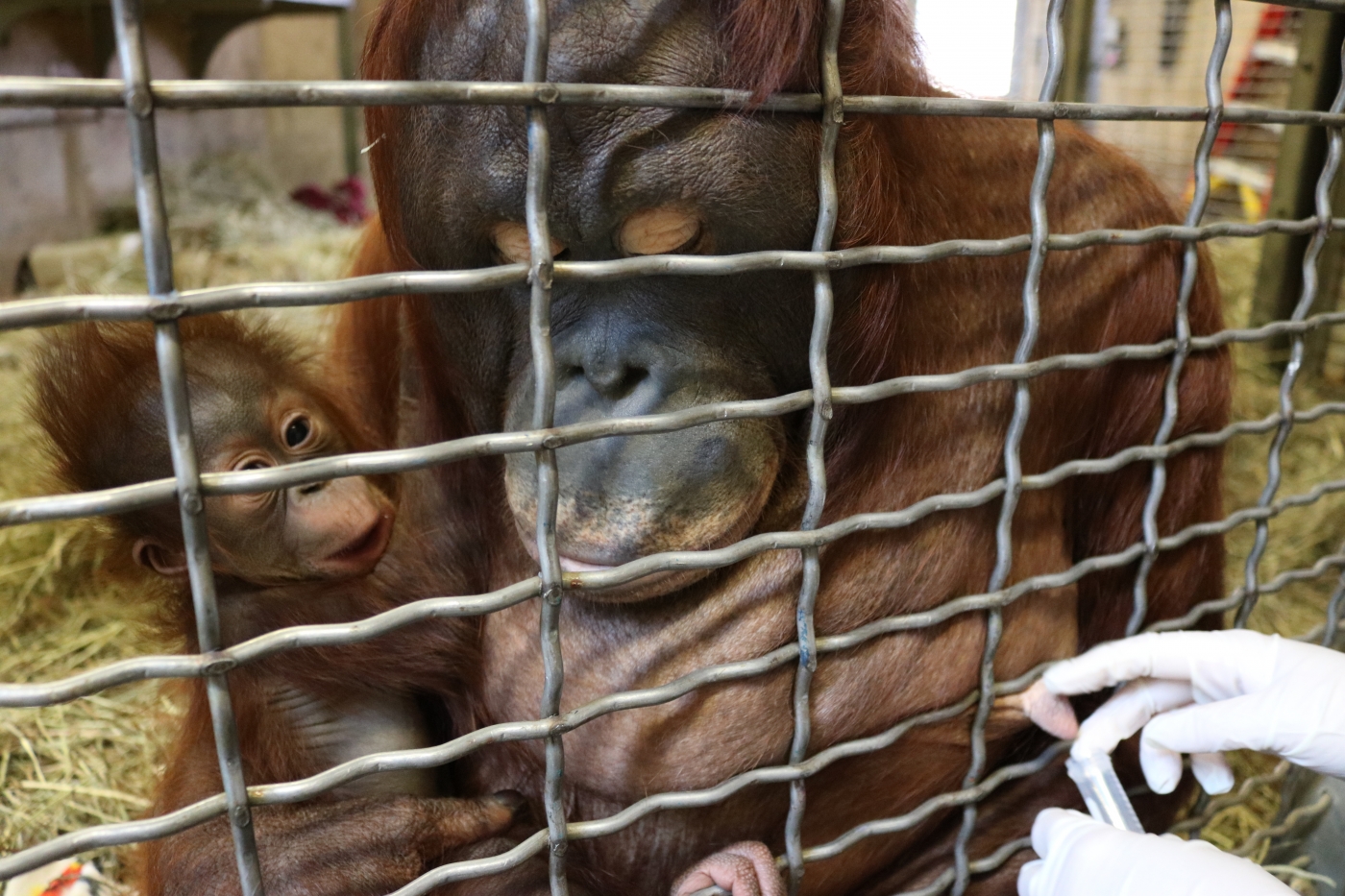
At four years old, Redd will continue to nurse for several more years. Up until Redd turned 3 years old, the primate team worked closely with Batang and trained her to voluntarily allow us to express milk. I collected samples weekly and shared them with the Smithsonian Conservation Biology Institute’s milk repository, which is home to the most extensive collection of exotic animal milks in the United States. Our nutritionists are studying the changes in Batang’s milk composition during her first few years of nursing, just like we did with our western lowland gorilla Mandara following Kibibi’s birth.
Redd is a pro on the O-Line, traversing the cables and towers between the Great Ape House and Think Tank with ease. He rarely rides on Batang’s back anymore, opting instead to go across via his signature moves. Orangutans’ hands and feet are specialized for swinging, and Redd demonstrates this as he “cartwheels” across the cables. He alternates hanging from his hands (right-side up) to his feet (upside down) and so on. Recently, he has started tight-rope walking the last few yards to the tower. It is heart-stopping to see in person, but he always makes it across!
Nothing stops primates from learning—not even a pandemic! Primates are closely related to humans and can easily catch viruses from us. Protecting our apes, monkeys and lemurs is paramount to our animal care team, so we wear personal protective equipment (PPE) at all times while working. Normally, when training a young primate like Redd, Moke or Allen’s swamp monkey Zawadi, we use training whistles to quickly capture the exact moment when they do the behavior asked of them. We’ve temporarily suspended using this tool for now, though, since our facemasks make it more difficult to use them. Instead, we just give them a verbal cue to let them know they’re on the right track.
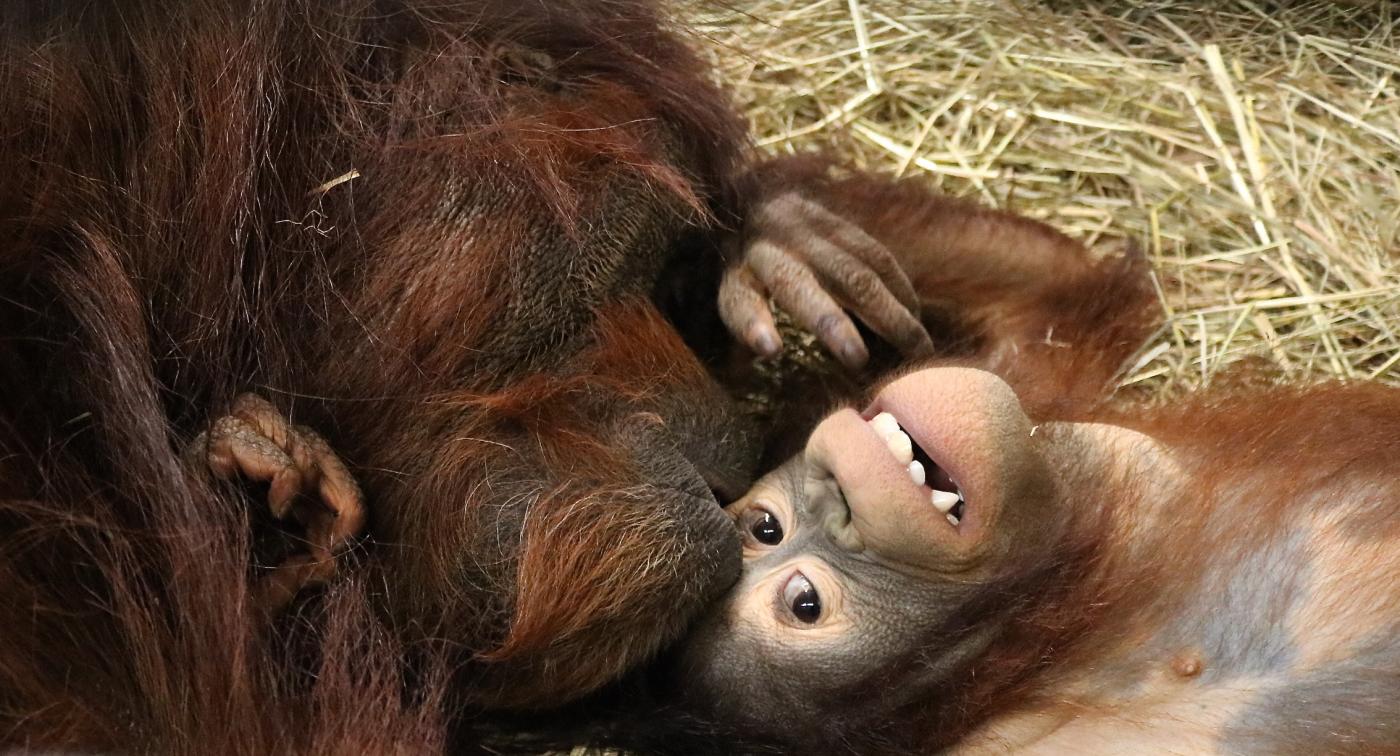
Over the past year, Redd added several new behaviors to his husbandry training repertoire. One of the most rewarding for me was training him to open his mouth on cue. Ever since Redd was just a few months old, we have been tracking his tooth development as part of an international study. Zoo keepers around the world take note of when their young orangutans’ deciduous and permanent teeth begin to emerge. Zoos share data with those working at orangutan sanctuaries in Indonesia and Malaysia to help them better estimate the ages of the animals in their care. It enables them to provide age-appropriate care as well as assess an orangutan’s readiness for reintroduction into the wild.
It’s exciting to have the opportunity to contribute to this important research and help Redd’s young counterparts in the wild. Previously, our team was only able to determine if Redd had any new teeth by getting a quick glimpse when he was yawning or playing. Now, he opens his mouth nice and wide whenever we give the cue. This process makes documenting his tooth development much easier. Redd currently has a full set of 20 baby teeth. He will continue to participate in this study until his 32 permanent adult teeth will come in, around the time he turns 7 or 8 years old.
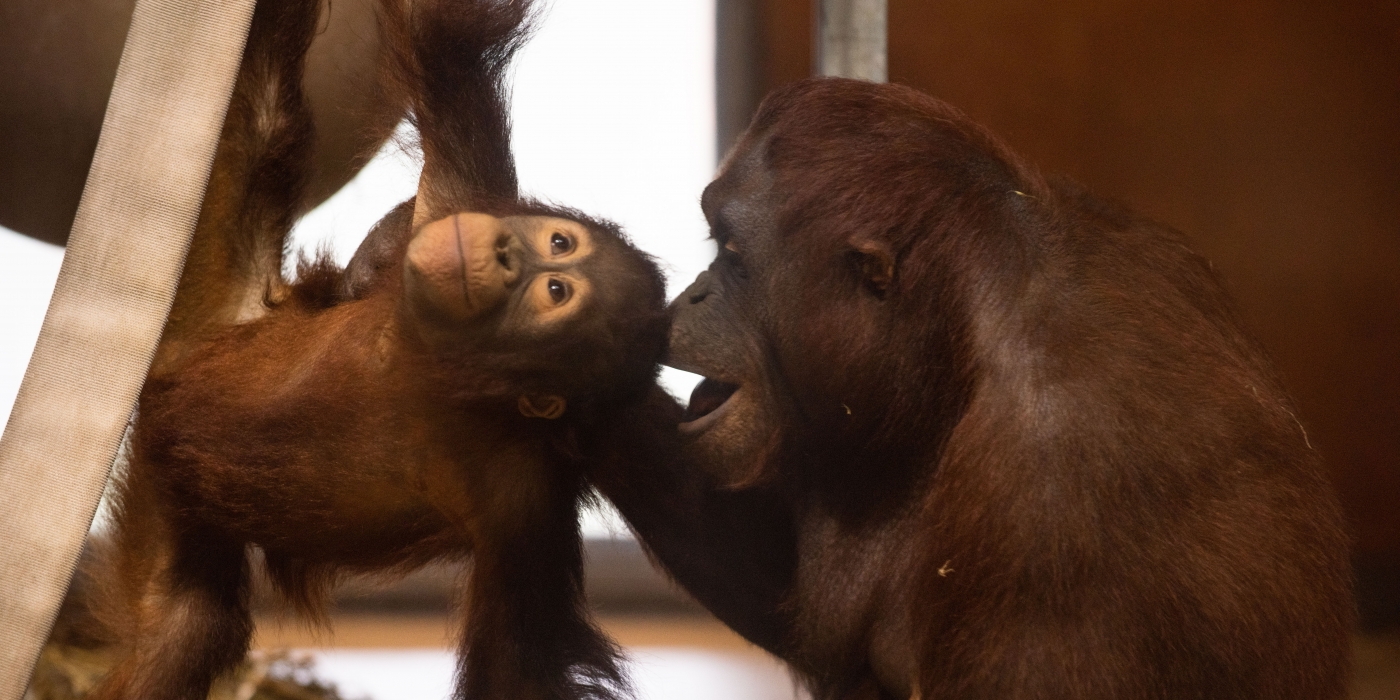
One of the challenges of training Redd is his proximity to Batang, funnily enough. A key component of our training program is offering food rewards when an animal does the correct behavior asked of him or her. Sometimes, if Redd is training and Batang is nearby, she will take his rewards from him!
To ensure Redd gets his fair share, we are beginning to train him to voluntarily separate from his mom for short periods of time. Starting this process while he is young will also enable us to separate him from Batang during morning and afternoon feedings. In addition to foraging for food, each orangutan receives their own diet prepared by our Department of Nutrition Sciences and specially developed for each individual’s age and metabolic needs.
In 2019, primate keeper Erin Stromberg trained Redd to voluntarily receive vaccines, including his annual flu shot!
As far as other training behaviors go, Redd has mastered presenting each of his hands and feet for inspection, as well as both hips and shoulders. The primate team is able to take his temperature using an ear thermometer and his oxygen saturation and heart rate using a pulse oximeter.
Recently, I was able to get an electrocardiogram reading on him, too, though he doesn’t quite sit still as well as the adults do! As a juvenile who is always on the go, Redd’s heart rate is faster than those of the adults. Redd averages 115 beats per minute, whereas the adults typically range between 70 and 90 beats per minute.
Like most ape juveniles, Redd spends the majority of his day playing. Because orangutans are so intelligent, we offer several different kinds of enrichment on any given day to help keep them physically fit and mentally sharp. Some enrichment puzzle feeders contain food and encourage the orangutans to use their dexterity and cognitive skills to get the treats out. Other times, we will put small foods—like popcorn, nuts and seeds—into paper bags, or scatter them throughout hay so the apes can forage. Other enrichment items—like blankets, boxes, wood shavings or paper—are just fun to hide under or roll around in. Sometimes, they will even use these items to make their nests!
Batang, in particular, is very fond of playing in water. When keepers are cleaning, Batang will get our attention and let it be known that she wants to play. She seems to really enjoy stomping around in the water spray. Redd watched her do this often when he was younger. These days, he will join in the fun, too, running through the spray trying to catch water in his mouth. By the time we are finished playing, Redd and Batang are soaked, but they have a great time. I’m sure it feels good in our hot Washington, D.C. summer!

Watching Redd and all of the primates play is one of the best parts of my job. Knowing how much joy they bring to me and all who have come to know them over the years only heightens my desire to help save their wild counterparts. All three species of orangutans—Bornean, Sumatran and Tapanuli—are considered critically endangered by the International Union for Conservation of Nature.
Though orangutans face many threats, including fires and illegal hunting and trafficking, the one that each of us can help reduce is habitat loss. If you want to help orangutans, look closely at the packaging of your favorite foods, cosmetics, and bath and household products. Ensure that you only use items that contain sustainable palm oil. There are several apps you can use to help you make orangutan-friendly shopping decisions. Check out the Orangutan Species Survival Plan website to get started!
Catch up on all of the latest orangutan happenings in Part I of this update. Want to celebrate Redd’s birthday by giving him a gift? Donate to the Enrichment Trunk. Your support directly benefits the animals at the Smithsonian’s National Zoo and Conservation Biology Institute.
Related Species:

